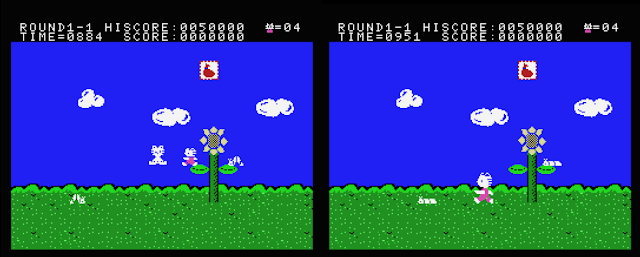The Epoch Super Cassette Vision was released in 1984, to try and take on Nintendo's Famicom, which hit store shelfs a year beforehand. It was the successor to a 1981 console named the Cassette Vision.
 |
| The Super Cassette Vision, taken from www.videogamelibrary.com |
What set the systems apart that while the Cassette Vision library will instantly remind anyone who even glances at it for a moment of Atari, the SCV could graphicaly stand up, and even beat, many early Famicom titles. The system even managed to get released in Europe and sell moderately well under the name Yeno.
However, the race was lost largely before it had truly begun and the SCV fell into obscurity, having only survived for two years while Epoch eventualy began releasing games on the Famicom in 1989.
The reason one brings this up is that, even though the system had a very small library, it managed to acquire some pretty impressive licenses in it's short run, these consisting of Doraemon, Lupin III, and even got to porting reasonabely remembered titles like Pole Position (II) and Boulder Dash. Amongst these was the game covered today
, Dragonball Dragon Dai Hikyou.
Interestingly enough this game came out the exact same year as the much despised
Dragonball Shenlong no Nazo on the Famicom, however, if availible release information is to be believed, Dragon Dai Hikyou preceeded it by a good two months. And not only that, but for all it's flaws, it's still a much better product, though sadly the system's swan song as well.
Right out of the gate the game surprises you by being.....a shooter. Probably the last genre you would think of when someone says Dragonball (and there is a bit of an issue in the fact we spend the whole game looking at Goku's back). But remember that this was 1986, and the series wasn't even halfway through it's first, pre "Z" ish faze.
You start off as Goku, flying on Nimbus, using your staff (which bends so much it looks like it's made of rubber) to attack airborne enemies while reserving your kamehameha's for ground based objects (think Twinbee, only much more destructive) though you can shoot stuff in front of you too, if you want. One of the first things you'll notice are the faces of your friends, strewn all over the place. These give you points, though sometimes they grant you other things, like auto fire on the staff, kamehameha's, or both (depending on whether you picked up Krillin, the Ox King, or Mutten Roshi). One of the second things you may notice is you can only go up halfway across the screen. In order to be able to get to the top of the screen you need to pick up a powerup.
Yes, I'm serious. You have to pick up a glowing red arrow which somehow gives Goku the ability to fly a tiny bit further ahead. You also lose it whenever you go to the next level.
There are basicly two types of enemies. Flying types that try to bump into you in various ways, (and the ocasional fish) and ground based enemies throwing crap at you. This ranges from the giant rabbit to the cyborg terminator thing to Pilaf. Interestingly, some of these behave a bit different from one another. Pilaf will only run a short distance from the egde of the screen before leaving, the cyborg goes back and forth in short patterns, while the others usualy just run from left to run/vice versa.
The end of the level consists of a large, seemingly barren area with many flying enemies and a whole bunch of containers on the ground. You have to bomb these to find the dragonball to move on to the next level, and the area will loop until you do. However sometimes amongst these boxes you will find a sign that says "End". And what does it do ?
It kicks your ass back to the title screen.
No I mean it. It literaly kicks you from the begining of the first level to the title screen. It also appeared on some later levels but I never had the balls to test what they do then.
Finaly, there is one more thing you can do. A few times throughout the game you will see Muten Roshi standing on the ground below. If you touch him, you're taken to a one on one duel with him. Now the first fight is manageable, if a bit weird due to the odd hit detection and stiff jump controls, but the later two fights are
impossible. Simply because Roshi has Kamehamehas now and will immediately begin using them right as the fight starts. You have no time to run away and if you jump over the first one, you'll descend so slowly that you won't have a chance to avoid the next one. And worst of all the AI will spam these every time you make a hit, aside from going off on a timer, and it will never stop shooting until it hits you. If you manage to somehow avoid two shots, he simply shoots a third and I never managed to dodge it.
 |
| The Ending. |
Overall, the game is a bit weird and has some odd concepts that one wouldn't normaly find in a shooter, even of this vintage, but they tried something and it mostly works, not to mention the graphics here, even with only showing the characters' bodies during the fight with Roshi, are absolutely stunning when compared to the Famicom game released two months after this one. There's also some nice touches here or there, like when Bulma throws you a capsule from a ship and you don't catch it in time it hits the ground and turns into a vehicle of some kind. I'd suggest giving this one a go, just because it's totally different then what you'd expect.


















